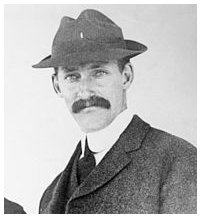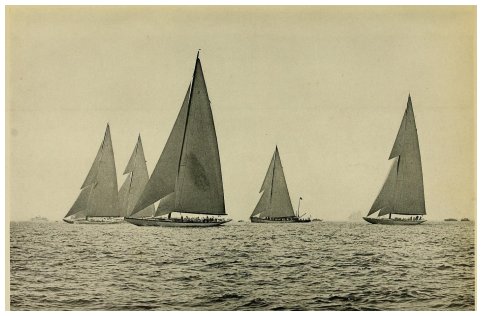Yves GARY Hits: 6306
Category: ENTERPRISE
 Enterprise, defender of the America's cup in 1930
Enterprise, defender of the America's cup in 1930
Immediately after the first meeting of the America's Cup Committee, Vice-Commodore Aldrich set about forming a syndicate of seven members: Vice-Commodore Winthrop W. Aldrich, Commodore Vincent Astor, Commodore George F. Baker, Jr., Captain Floyd L. Carlisle, Commodore E. Walter Clark, Commodore Harold S. Vanderbilt.
Commodore Harold S. Vanderbilt accepts to be captain of this syndicate that agreeds to request W. Starling Burgess to design and the Herreshoff Manufacturing Company to build the boat.
 Starling Burgess had designed a large number of successful 12-metre and M class boats, and the 75-foot Marconi-rigged sloop Blackshear. Years before, Edward Burgess, his father, had designed the successful Cup Defenders Puritan, Mayflower, and Volunteer. Since childhood the son's dream and ambition had been to follow in his father's footsteps. The Herreshoff Company said that they would be delighted to build the boat to Burgess's design. They had built the last five defenders of The America's Cup, the Vigilant, the Defender, the Columbia, the Reliance, and the Resolute. All of these were designed by the famous "Wizard of Bristol," Nathaniel G. Herreshoff, who, while he had been forced by advancing years to retire from the arduous work of designing, was still acting in an advisory capacity to his company.
Starling Burgess had designed a large number of successful 12-metre and M class boats, and the 75-foot Marconi-rigged sloop Blackshear. Years before, Edward Burgess, his father, had designed the successful Cup Defenders Puritan, Mayflower, and Volunteer. Since childhood the son's dream and ambition had been to follow in his father's footsteps. The Herreshoff Company said that they would be delighted to build the boat to Burgess's design. They had built the last five defenders of The America's Cup, the Vigilant, the Defender, the Columbia, the Reliance, and the Resolute. All of these were designed by the famous "Wizard of Bristol," Nathaniel G. Herreshoff, who, while he had been forced by advancing years to retire from the arduous work of designing, was still acting in an advisory capacity to his company.
Burgess at once started work on the lines and model. He made two models of a sloop 80 feet on the waterline, which were submitted for the inspection of syndicate members during the New York Yacht Club cruise in August. The one finally selected, curiously enough, was the individual choice of all the syndicate members who saw both of them. It had relatively large beam, displacement concentrated amidships and V sections forward. Starling Burgess explained that the V type bow would be a little faster in light airs, although it would pound more in a seaway, when the boat was sailing at a pronounced angle of heel, and that in his opinion the greater beam was necessary in order to secure the required stability.
As soon as the waterline length was determined, and the model chosen, an order was placed with the Herreshoff Manufacturing Company for the steel frames and bronze plating for the hull, the lead for the keel, the white pine for the deck, and all other material required for hull construction.
Enterprise was launched on April 14, christened by Mrs. Winthrop W. Aldrich, her sponsor, and assisted by Governor Case of Rhode Island. Just as the Enterprise's stern projected beyond the open doors of the south shop, the fog burned off and the sun shone brightly — an auspicious omen! Ten minutes later she was afloat and clear of the railway. Two hours earlier Shamrock V had been sent down the ways at Gosport, England.
Ten minutes later she was afloat and clear of the railway. Two hours earlier Shamrock V had been sent down the ways at Gosport, England.
By Saturday noon, April 19, the weather showed signs of clearing and Enterprise had his first trial trip. The following morning we again made sail in a light northwest breeze. We tried our small jib topsail and later our small ballooner. After about two hours' sailing, the wind dying out, we returned to City Island. On Friday, April 25, it was the first opportunity to try Enterprise to windward, and to note the effects of the centreboards.
For her preparation, Enterprise had a series of regular races against Resolute and Vanitie from May 10 to 29. After a short tuning-up period, Enterprise had his first serie of races between Cup-defense candidates from June 11 to 25.
Then, from July 6 to 17, the four candidates would race in pairs over the America's Cup course. After 10 Observation races, three boats are virtually ex-æquo: Weetamoe, Enterprise and Yankee. It is then the Annual Cruise of the New York Yacht Club with seven races from August 2 to 9. With 21 points, Enterprise is the winner before Weetamoe, 16 points. For the trial races, Enterprise beat Weetamoe on August 20 and August 21. After a third trial race cancelled on August 27, the America's Cup Committee had a meeting on board the Flagship and decided that Enterprise is selected to defend the America's Cup.

 - From 13 to 18 September 1930, at Newport.
- From 13 to 18 September 1930, at Newport.
- The match shall be decided by the best four out of seven races.
- The time of the starting signal shall be taken as the time of the start of both yachts.
- Starting signals to be given at 11:30 o'clock; the warning signal to be fired ten minutes before starting signal, and the preparatory signal five minutes before.
- time limit for races five and a half hours.
- the first, third and fifth races to be to windward and leeward, the second and fourth over a triangle, all courses to be thirty miles, and laid to windward when possible.
- There shall be no time allowance.
Enterprise is confronted to Shamrock V, the challenger of Royal Ulster Yacht Club.
Enterprise beat Shamrock V four wins to nil.
- September 13, 1st race, 30 miles, windward-leeward : Enterprise beat Shamrock V by 2 mn 52 s.
- September 15, 2nd race, 30 miles, triangle : Enterprise beat Shamrock V by 9 mn 34 s
- September 17, 3rd race, 30 miles, windward-leeward : Shamrock V abandoned on accident. Enterprise ends in 3 h 54 mn 16 s.
- September 18, 4th race, 30 miles, triangle : Enterprise beat Shamrock V by 5 mn 44 s.

Enterprise is not to race next Summer. She will not even be put in commission, but remain snug out of the water at the Herreshoff yard in Bristol, R.I., where she was taken after she defeated Sir Thomas Lipton's Shamrock V off Newport in September. She stay here until 1935 when she will be scrapped.
